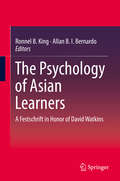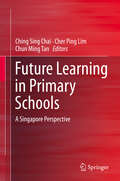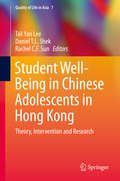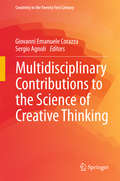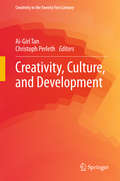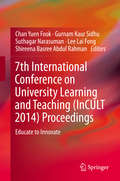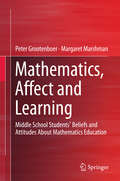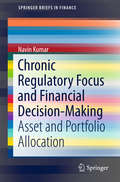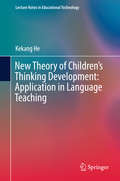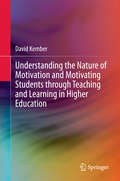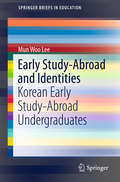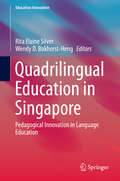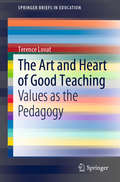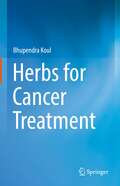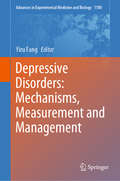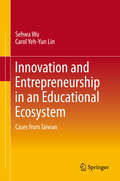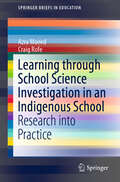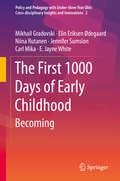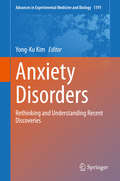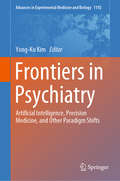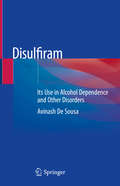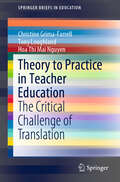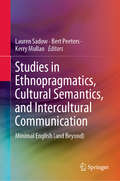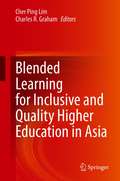- Table View
- List View
The Psychology of Asian Learners: A Festschrift in Honor of David Watkins
by Ronnel B. King Allan B. I. BernardoThis book celebrates the scholarly achievements of Prof. David A. Watkins, who has pioneered research on the psychology of Asian learners, and helps readers grasp the cognitive, motivational, developmental, and socio-cultural aspects of Asian learners learning experiences. A wide range of empirical and review papers, which examine the characteristics of these experiences as they are shaped by both the particularities of diverse educational systems/cultural milieus and universal principles of human learning and development, are showcased. The individual chapters, which explore learners from fourteen Asian countries, autonomous regions, and/or economies, build on research themes and approaches from Prof. Watkins’ research work, and are proof of the broad importance and enduring relevance of his seminal psychological research on learners and the learning process.
Future Learning in Primary Schools: A Singapore Perspective
by Ching Sing Chai Cher Ping Lim Chun Ming TanThis edited book tells the story of the multifaceted efforts devoted by a “future school” in Singapore—The Nan Chiau Primary School—in shaping future learning. It documents the various measures implemented by one primary school to improve student learning outcomes in a technology-rich teaching and learning environment. With the current interest in Singapore’s “Masterplan for ICT (information and communication technology) in Education,” and the increasing focus on teaching and learning design by leading education researchers and professionals, this well-timed book will appeal to policy makers, educators and researchers.
Student Well-Being in Chinese Adolescents in Hong Kong: Theory, Intervention and Research (Quality of Life in Asia #7)
by Tak Yan Lee Daniel T.L. Shek Rachel C. F. SunThis book reviews the theories regarding commonly occurring developmental issues among Chinese adolescents in Hong Kong, the application of Positive Youth Development (PYD) to a large-scale primary prevention program and the impact of PYD on student well-being, indexed according to adolescent developmental issue. Using multiple strategies, it presents the overall constructs and frameworks supporting P.A.T.H.S. in response to the various psychosocial needs of Hong Kong’s youth. Some of the issues covered include substance abuse, sexual behavior, internet addiction, bullying and cyber-bullying. The book argues for the effectiveness of the school-based program in promoting student well-being in modern Hong Kong society and will be of interest to undergraduate and postgraduate students, university instructors, researchers, social workers, pediatricians, youth workers, educators, administrators, psychologists, school principals and allied professionals looking to promote whole-person development in junior form students and especially those with an interest in education in China.
Multidisciplinary Contributions to the Science of Creative Thinking (Creativity in the Twenty First Century)
by Giovanni Emanuele Corazza Sergio AgnoliThis book offers a multidisciplinary and multi-domain approach to the most recent research results in the field of creative thinking and creativity, authored by renowned international experts. By presenting contributions from different scientific and artistic domains, the book offers a comprehensive description of the state of the art on creativity research. Specifically, the chapters are organized into four parts: 1) Theoretical Aspects of Creativity; 2) Social Aspects of Creativity; 3) Creativity in Design and Engineering; 4) Creativity in Art and Science. In this way, the book becomes a necessary platform for generative dialogue between disciplines that are typically divided by separating walls.
Building Autonomous Learners: Perspectives from Research and Practice using Self-Determination Theory
by Woon Chia Liu John Chee Keng Wang Richard M. RyanThis edited work presents a collection of papers on motivation research in education around the globe. Pursuing a uniquely international approach, it also features selected research studies conducted in Singapore under the auspices of the Motivation in Educational Research Lab, National Institute of Education, Singapore.A total of 15 chapters include some of the latest findings on theory and practical applications alike, prepared by internationally respected researchers in the field of motivation research in education. Each author provides his/her perspective and practical strategies on how to maximize motivation in the classroom. Individual chapters focus on theoretical and practical considerations, parental involvement, teachers’ motivation, ways to create a self-motivating classroom, use of ICT, and nurturing a passion for learning.The book will appeal to several different audiences: firstly, policymakers in education, school leaders and teachers will find it a valuable resource. Secondly, it offers a helpful guide for researchers and teacher educators in pre-service and postgraduate teacher education programmes. And thirdly, parents who want to help their children pursue lifelong learning will benefit from reading this book.
Creativity, Culture, and Development (Creativity in the Twenty First Century)
by Ai-Girl Tan Christoph PerlethThis volume presents a collection of writings on the relations among creativity, culture and development. The editors invited “like-minded” researchers of creativity from around the world to share their respective notions of creativity. Given that human creativity is a potential that can and should be nurtured in the course of lifespan development and across all cultural backgrounds, the volume emphasizes the importance of promoting creativity in all cultures and through societal-educational opportunities, and offers a venue for the authors to make conceptual, empirical and practical inquiries into the relations among creativity, development and culture. The authors represent a varied “mix” of contemporary and emerging creativity researchers who use different methodologies to investigate the importance of culture in creativity development and the reciprocal role of developing creativity and cultural enrichment. The volume represents an attempt on the part of the editors and the authors to broaden our current understanding of creativity in the contexts of human and cultural development, and in so doing to enhance our understanding of creativity, culture and development in the contexts of flourishing human and societal activities. As the first volume in a book series on “Creativity in the Twenty-First Century”, the book invites readers and researchers to engage in future interdisciplinary and intercultural discourses and dialogues on the importance of creativity for human and cultural development.
7th International Conference on University Learning and Teaching (InCULT 2014) Proceedings: Educate to Innovate
by Chan Yuen Fook Gurnam Kaur Sidhu Suthagar Narasuman Lee Lai Fong Shireena Basree Abdul RahmanThe book comprises papers presented at the 7th International Conference on University Learning and Teaching (InCULT) 2014, which was hosted by the Asian Centre for Research on University Learning and Teaching (ACRULeT) located at the Faculty of Education, Universiti Teknologi MARA, Shah Alam, Malaysia. It was co-hosted by the University of Hertfordshire, UK; the University of South Australia; the University of Ohio, USA; Taylor’s University, Malaysia and the Training Academy for Higher Education (AKEPT), Ministry of Education, Malaysia. A total of 165 papers were presented by speakers from around the world based on the theme “Educate to Innovate in the 21st Century.” The papers in this timely book cover the latest developments, issues and concerns in the field of teaching and learning and provide a valuable reference resource on university teaching and learning for lecturers, educators, researchers and policy makers.
Mathematics, Affect and Learning: Middle School Students’ Beliefs and Attitudes About Mathematics Education (SpringerBriefs in Education)
by Peter Grootenboer Margaret MarshmanThis book examines the beliefs, attitudes, values and emotions of students in Years 5 to 8 (aged 10 to 14 years) about mathematics and mathematics education. Fundamentally, this book focuses on the development of affective views and responses towards mathematics and mathematics learning. Furthermore, it seems that students develop their more negative views of mathematics during the middle school years (Years 5 to 8), and so here we concentrate on students in this critical period. The book is based on a number of empirical studies, including an enquiry undertaken with 45 children in Years 5 and 6 in one school; a large-scale quantitative study undertaken with students from a range of schools across diverse communities in New Zealand; and two related small-scale studies with junior secondary students in Australia. This book brings substantial, empirically-based evidence to the widely held perception that many students have negative views of mathematics, and these affective responses develop during the middle years of school. The data for this book were collected with school students, and students who were actually engaged in learning mathematics in their crucial middle school years. The findings reported and discussed here are relevant for researchers and mathematics educators, policy makers and curriculum developers, and teachers and school principals engaged in the teaching of mathematics.
Chronic Regulatory Focus and Financial Decision-Making: Asset and Portfolio Allocation (SpringerBriefs in Finance)
by Navin KumarIn this book, the relationship between financial decision-making and chronic regulatory focus is explored to provide a better understanding of consumer decisions. Financial decisions are modelled on the basis of assets and portfolios sensitive to particular regulatory foci. Studies in the book test whether participants select assets/portfolios that conform to their respective foci. In addition, given that gender, age and education can shape financial decisions, further hypotheses are put forth to explore whether these are related to asset and portfolio selection and regulatory focus. As consumers tend to make financial decisions prior to priming, this book diverts from previous research involving primed states of regulatory focus and instead explores the chronic state. The study employs two complementary instruments, the eye tracker and self-report, to explicate the hypotheses. As the main hypotheses were not supported, the author posits that the harsh worldwide financial climate may have acted as an external influence, moving participants to select assets and portfolios not aligned with their foci. This study marks a valuable contribution to the current literature concerning financial decision-making, the underlying motivational systems and external influences, and will promote further research in these areas. It offers an essential resource for academics and students interested in how regulatory focus interacts with financial decisions and the overarching economic climate.
New Theory of Children’s Thinking Development: Application in Language Teaching (Lecture Notes in Educational Technology)
by Kekang HeThis book proposes a new theory on children’s thinking (cognitive) development. According to this theory, the stages of said development should be divided into four stages: first, the stage of animalistic thinking (birth–before possessing basic language ability); second, the stage of elementary thinking (beginning to possess basic language ability–beginning to possess proficient oral ability); third, the stage of intermediate thinking (beginning to possess proficient oral ability–before the formation of comprehensive cognitive ability); and fourth, the stage of advanced thinking (after the formation of comprehensive cognitive ability). In this context, thinking includes logical thinking, visual thinking and intuitive thinking. Based on the new theory, the author points out the serious negative impact that Piaget’s stage theory of children’s cognitive development has had on Chinese language education in China. The book also offers a number of practical principles, such as five teaching activities for language teaching of extension, typing, writing, passage, and thinking.
Understanding the Nature of Motivation and Motivating Students through Teaching and Learning in Higher Education (SpringerBriefs in Education #0)
by David KemberThis book is based upon three interrelated open naturalistic studies conducted to better characterise the motivational orientation of students in higher education. Open semi-structured individual interviews were conducted with undergraduates, students at community colleges and students in taught postgraduate courses in Hong Kong. The analysis used an exploratory grounded theory approach and resulted in a motivational orientation framework with six continua with positive and negative poles. On enrolment students had positions on the six facets of motivation, which shifted as they progressed through their degree according to their perceptions of the teaching and learning environment. The framework can, therefore, be used to explain both initial decisions to enrol and motivation to continue studying. The interviews included descriptions of teaching approaches and learning activities and their effects on motivation. This made it possible to describe a teaching and learning environment conducive to motivation, with eight supportive conditions. Each facet of the teaching and learning environment is illustrated with quotations from the three groups of students, resulting in a guide to configuring a teaching and learning environment conducive to motivating students. The emerging community-college sector in Hong Kong is used as a case study of the effects on student motivation of the expansion of the higher education sector through private colleges. Cultural issues are discussed, particularly the performance of Asian students relative to those in the West.
Early Study-Abroad and Identities: Korean Early Study-Abroad Undergraduates (SpringerBriefs in Education #0)
by Mun Woo LeeThis book investigates how transnational English learning experiences can influence students’ identities. More specifically, it delineates how Korean early study abroad undergraduates perceive English and how they have formed their ethnic identities based on their early study abroad experiences. They tend to see themselves “in between” two cultures/languages and this in-between-ness is the most distinctive common characteristic of their identities. However, their in-between-ness means more than being connected to both Korea and America or hybridizing Korean and American discourses. As transnational elites who cross the borders freely, they are in a position to be cosmopolitans who can take advantage of the in-between-ness, becoming keen critics of dominant cultures in both contexts, and potentially social activists who can stand up for social justice. In short, the early study abroad experience should be understood not just in terms of language learning, but as a process by means of which learners develop social awareness in multiple language-related contexts that can lead them beyond their own circumscribed world of elitism to a position of responsibility for sharing what they have experienced and learned for the benefit of society.
Quadrilingual Education in Singapore: Pedagogical Innovation in Language Education (Education Innovation Series)
by Rita Elaine Silver Wendy D. Bokhorst-HengThis book explores Singapore’s language education system. Unlike previous volumes, which discuss the bilingual requirement for learning, it focuses on Singapore’s quadrilingual system, bringing together articles on each of the four languages – English, Mandarin, Malay and Tamil – as well as articles that examine more than one language. It highlights past successes, current concerns, and future directions for language education. The book focuses on classroom pedagogy in all four official languages, showcasing how languages are taught and learned in Singapore as a basis for better understanding the system “from the inside out.” The authors present empirical, classroom-based studies on language pedagogy in all four languages, as well as updated information on the current socio-political context and how it has influenced attempts at pedagogical innovation. Consideration is given to the dialectical relationship between policy and practice. The chapters also include discussions of pre-school-age learning, influences of language policy, home literacy practices, and commentaries by international language-in-education scholars. This approach also provides a basis for international comparison – especially for those who are interested in fostering English proficiency while maintaining one or more national languages. The volume is particularly important in light of the continuing international efforts to integrate English into national educational systems where it is not the dominant language.
The Art and Heart of Good Teaching: Values as the Pedagogy (SpringerBriefs in Education)
by Terence LovatThis book summarizes and updates findings from the Australian Values Education Program with a focus on the latest international research in the field, both theoretical and practice-based. Further, it provides a theoretical and practical basis for understanding the disenchantment with low-level accountability approaches to learning (e.g. NAPLAN in Australia). In turn, the book demonstrates the effectiveness of Values Education as a holistic pedagogy with the potential to enhance students’ learning effects in terms of their personal, social, emotional and academic development. It offers well-tested alternative pedagogical approaches, based on research insights largely originating from actual classroom-based practice.
Herbs for Cancer Treatment
by Bhupendra KoulThis book provides detailed information on the various types of cancer, etiology, effects, and challenges associated with current cancer treatment regimes. The present edition has been written to reflect recent developments, success rates and lacunae in herbal and modern cancer therapies. It also describes the use of several herbal formulations to boost patients’ immunity, in order to prevent or help them cope with several cancers. The book highlights several herbs/shrubs/trees that have been reported to possess anti-cancer properties, paving the way for in-depth research into the dose standardization and efficacy of plant-based bioactive molecules. It also focuses on the sustainable conservation of medicinal flora, so that, in future, novel biomolecules be extracted and made available for the treatment of various cancers. Given its highly relevant content, the book will benefit the entire cancer research community (students, scientists, pharmacists, herbalists and lecturers) at universities, research institutions and industry in the areas of oncology, herbal cancer therapy, biotechnology, drug discovery, pharmaceuticals, agriculture, and various disciplines of the biomedical sciences.
Depressive Disorders: Mechanisms, Measurement and Management (Advances in Experimental Medicine and Biology #1180)
by Yiru FangThis book offers a state-of-the-art report on recent discoveries concerning the basic and clinical, neuroscientific and psychiatric findings in depression research. Depressive disorder is a severe and recurrent brain disorder that can manifest in depressive mood, somatic symptoms and cognitive impairment. The underlying mechanisms of depressive disorder and its clinical practice are subjects of long-standing interests. This book is a biologically plausible and multilevel theory which describes neural, physiological, molecular and genomic mechanisms that drive depression pathogenesis, as well as navigates the clinical practice and management for depressive disorder. It mainly describes advances made over the past 20 years on the neural, molecular, neuroimaging, physiology, pathophysiology, pharmacology and internet-based measurement and management of depressive disorder. It will help postgraduate students and academic researchers to get either basic or clinical picture of depressive disorder. Also, it may benefit pharmaceutical companies for developing novel drugs to treat this disease.
Innovation and Entrepreneurship in an Educational Ecosystem: Cases from Taiwan
by Carol Yeh-Yun Lin Sehwa WuThis book reports on 12 education innovation cases in Taiwan and focus particularly on an ecosystem to demonstrate innovation as a competitive advantage and requires an ecosystem to be sustainable in virtually all disciplines. It also covers the trend of education innovation in many countries, with “education entrepreneurship” being the frequently used description. The 12 educators highlighted here are even more entrepreneurial than many businesspeople. Generally, schools are required to follow certain rules, especially the public schools. Accordingly, the book also describes how these education entrepreneurs have innovatively created a fostering environment under challenging constraints to facilitate the success of students, teachers, and even the local community. Six of the cases involve school-based innovation, while the other six focus on student-based innovation. Their stories provide valuable insights for all companies seeking to become more innovative in a resource-constrained setting.
Learning Through School Science Investigation in an Indigenous School: Research into Practice (SpringerBriefs in Education)
by Azra Moeed Craig RofeThis book presents the findings of a case study conducted in a Māori medium school where a space was created for Pūtaiao (Western science) teaching and learning from year 1 to 13. Science is currently taught in Te Reo Māori in primary school and in English in secondary school, and evidence suggests that students are engaging in science education, learning to investigate, and achieving in science. In New Zealand, most students attend English medium state schools; however, approximately 15% of indegenous students attend Māori medium schools. These schools are underpinned with Kura Kaupapa Māori philosophy, which is culturally specific to Māori and aims to revitalise the Māori language, and Māori knowledge and culture. Māori students’ engagement and achievement continues to be a challenge for both mainstream and Māori medium schools, teachers and students due to lack of access to science teachers who can teach in Te Reo Māori. School leaders and whanau (families) believed that by year 9 (age 13) their students had developed their identity as Māori, and were proficient in Te Reo Māori. They wanted their students to have the option to learn science, experience success and have the choice to conitnue in science, so they made the difficult decision for science to be taught in English in secondary school. The book discusses how teachers in indigenous schools, who have extensive knowledge of culture and context specific pedagogies, can gain confidence to teach science through collaboration with and support from researchers with whom they have developed strong professional relationships.
The First 1000 Days of Early Childhood: Becoming (Policy and Pedagogy with Under-three Year Olds: Cross-disciplinary Insights and Innovations #2)
by E. Jayne White Jennifer Sumsion Elin Eriksen Ødegaard Carl Mika Mikhail Gradovski Niina RutanenThis book provides a philosophical, socio-political and theoretical understanding of the notion of Becoming in the context of the related concepts, and in contemplation of the notion of Being. Deriving from different traditions from various countries, these concepts act as windows on contemporary early years settings and communities around the world where adults map out infant becomings. This book is a valuable resource for early childhood educators, students, professionals, researchers, and policy makers around the globe who seek to understand the locatedness of infant becomings in space and time.
Anxiety Disorders: Rethinking and Understanding Recent Discoveries (Advances in Experimental Medicine and Biology #1191)
by Yong-Ku KimThis book reviews all important aspects of anxiety disorders with the aim of shedding new light on these disorders through combined understanding of traditional and novel paradigms. The book is divided into five sections, the first of which reinterprets anxiety from a network science perspective, examining the altered topological properties of brain networks in anxiety disorders. The second section discusses recent advances in understanding of the neurobiology of anxiety disorders, covering, for example, gene-environmental interactions and the roles of neurotransmitter systems and the oxytocin system. A wide range of diagnostic and clinical issues in anxiety disorders are then addressed, before turning attention to contemporary treatment approaches in the context of novel bio-psychosocial-behavioral models, including bio- and neurofeedback, cognitive behavioral therapy, neurostimulation, virtual reality exposure therapy, pharmacological interventions, psychodynamic therapy, and CAM options. The final section is devoted to precision psychiatry in anxiety disorders, an increasingly important area as we move toward personalized treatment.Anxiety Disorders will be of interest for all researchers and clinicians in the field.
Frontiers in Psychiatry: Artificial Intelligence, Precision Medicine, and Other Paradigm Shifts (Advances in Experimental Medicine and Biology #1192)
by Yong-Ku KimThis book reviews key recent advances and new frontiers within psychiatric research and clinical practice. These advances either represent or are enabling paradigm shifts in the discipline and are influencing how we observe, derive and test hypotheses, and intervene. Progress in information technology is allowing the collection of scattered, fragmented data and the discovery of hidden meanings from stored data, and the impacts on psychiatry are fully explored. Detailed attention is also paid to the applications of artificial intelligence, machine learning, and data science technology in psychiatry and to their role in the development of new hypotheses, which in turn promise to lead to new discoveries and treatments. Emerging research methods for precision medicine are discussed, as are a variety of novel theoretical frameworks for research, such as theoretical psychiatry, the developmental approach to the definition of psychopathology, and the theory of constructed emotion. The concluding section considers novel interventions and treatment avenues, including psychobiotics, the use of neuromodulation to augment cognitive control of emotion, and the role of the telomere-telomerase system in psychopharmacological interventions.
Disulfiram: Its Use in Alcohol Dependence and Other Disorders
by Avinash De SousaThis book focuses on the value of supervised Disulfiram therapy, highlighting the many potential and unique benefits of Disulfiram. One of the oldest drugs available for the long-term management of alcohol dependence, Disulfiram remains a viable treatment option for alcohol dependence and has been shown in recent studies to be more successful in treating patients with alcohol dependence than Naltrexone, Topiramate and Acamprosate. It is also useful in dual diagnosis patients and those with co-morbid cocaine and alcohol dependence. Although Disulfiram’s mechanism of action in alcohol dependence was long thought to be its effects as a psychological deterrent, more recent studies point to potential anti-craving effects as well. In dedicated chapters, the book reviews major clinical trials of Disulfiram spanning nearly 60 years, its historical aspects and discovery, side effects, treatment protocols and uses in the context of alcohol dependence. The book also discusses the use of Disulfiram across diverse populations along with monitoring for compliance and various adverse effects that may manifest. Further topics include Disulfiram implant therapy and the role of Disulfiram in the modern long-term pharmacotherapy of alcohol dependence, as well as the role of cognitive behavior therapy in enhancing the effects of Disulfiram and the emerging role of Disulfiram in treating cocaine dependence and pathological gambling. As such, the book offers a “one-stop” comprehensive guide to all aspects of Disulfiram therapy.
Theory to Practice in Teacher Education: The Critical Challenge of Translation (SpringerBriefs in Education)
by Christine Grima-Farrell Tony Loughland Hoa Thi NguyenThis book offers a theoretically and empirically robust account of what is known about the effective approaches that translate theory to practice in teacher education, presenting evidence from case studies from a diverse range of contexts informed by various methodological foundations. It also provides accounts that support teacher educators involved in both school and university based teacher education.The book offers insights into the translation of theory to practice from the long history of teacher education, the benefit of diverse approaches in terms of the effectiveness of initial teacher education, and the impact of professional standards.
Studies in Ethnopragmatics, Cultural Semantics, and Intercultural Communication: Minimal English (and Beyond)
by Lauren Sadow Bert Peeters Kerry MullanThis book is the third in a three-volume set that celebrates the career and achievements of Cliff Goddard, a pioneer of the Natural Semantic Metalanguage approach in linguistics. This third volume explores the potential of Minimal English, a recent offshoot of the Natural Semantic Metalanguage, with special reference to its use in Language Teaching and Intercultural Communication.Often considered the most fully developed, comprehensive and practical approach to cross-linguistic and cross-cultural semantics, Natural Semantic Metalanguage is based on evidence that there is a small core of basic, universal meanings (semantic primes) that can be expressed in all languages. It has been used for linguistic and cultural analysis in such diverse fields as semantics, cross-cultural communication, language teaching, humour studies and applied linguistics, and has reached far beyond the boundaries of linguistics into ethnopsychology, anthropology, history, political science, the medical humanities and ethics.
Blended Learning for Inclusive and Quality Higher Education in Asia
by Charles R. Graham Cher Ping LimThis book demonstrates how blended learning improves access to and enhances the quality of higher education teaching and learning in Asian universities. It first discusses how leading universities in the region drive and support blended learning at the institutional level to enhance student learning engagement and outcomes. It then examines 10 effective implementations and lessons learned of blended learning practices across different disciplinary courses and programmes (humanities and language, science and engineering, social science and education, and others) in the region. The chapters in this book provide an overview of the opportunities and challenges of blended learning for improved access and enhanced quality of higher education, and offer insights into the promising blended learning policies and practices in Asian universities.
